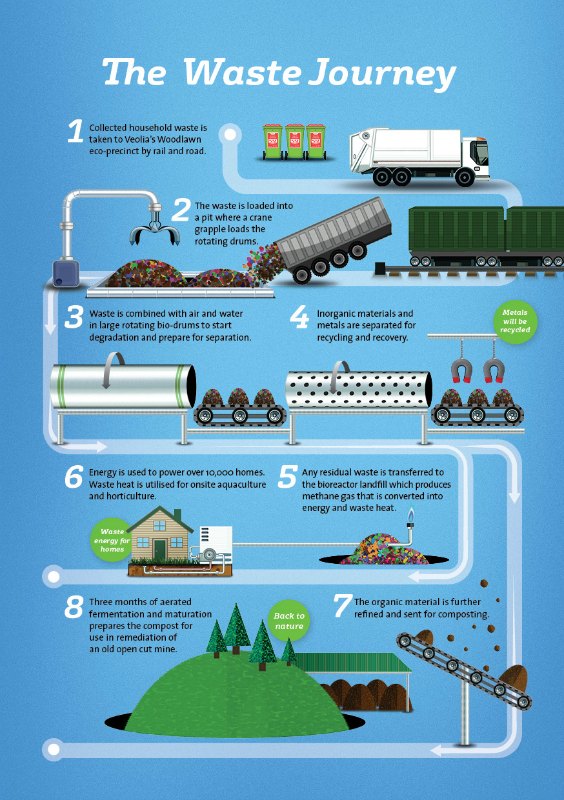Lane Cove Council and four other councils in the Northern Sydney Region send the contents of red–lid waste bins to a purpose-built Mechanical Biological Treatment (MBT) facility at Woodlawn, south of Sydney. The waste is taken by truck and train to the facility, which also processes waste from some councils in the South Sydney area.
Approximately 50% of Lane Cove’s red lid bin waste is diverted from landfill and converted into Mixed Waste Organic Output (MWOO).
Veolia manages the facility and is responsible for transforming the waste from red-lidded Lane Cove and other North Shore councils’ bins into MWOO for environmental rehabilitation.
The NSW Environment Protection Authority (EPA) has fined Veolia Environmental Services (Australia) Pty $30,000 after failing to comply with the conditions of the Environment Protection Licence covering the MBT facility.
History of Odour Issues at Woodlawn MBT
The EPA notes the following on their website:
“We are aware that the community has been experiencing ongoing odours around the Tarago area and are investigating. We appreciate that odours can be unpleasant and can impact quality of life.
We are reviewing each report of odour and requiring Veolia Environmental Solutions (Australia) Pty Ltd (Veolia) to improve odour management at its Woodlawn Eco Precinct.
We use a variety of regulatory approaches to ensure Veolia put measures in place to prevent odour and comply with their licence.”
Why Was Veolia Fined?
The EPA has previously issued Veolia a formal warning and official cautions regarding non-compliance with licence conditions at the Mechanical Biological Treatment facility.
During a routine inspection of the facility in April this year, EPA officers observed a large amount of leachate collecting on compost pads. Further inspection revealed that the drain designed to transfer leachate from the pads to the treatment dam was blocked, causing the liquid to back up and flood the pads.
NSW EPA Executive Director of Operations, Jason Gordon, said the incident had the potential to cause odour issues and could have been avoided if more effective measures were in place.
“We expect all EPA licenced waste facilities to comply with the conditions of their licence, which includes maintaining and operating plants and their equipment in a proper and efficient manner. This was a clear failure to do so,” Mr Gordon said.
“Proper management of composting activities involving leachate – the contaminated liquid generated during the composting process – is crucial to prevent the pollution of subsoil, groundwater, and surface water, as well as offensive odours that can escape and impact neighbouring communities.
“In our view, this incident was preventable. Not only was the drain blocked but the leachate dam it served was full and resources available to help better manage the situation were not used. In this case, temporary rubber storage bladders should have been used by Veolia to store the excess leachate and create capacity in the dam.”
Woodlawn MBT Facility Issues
In addition to odour issues, the future of MBT looked in doubt when, in October 2018, the EPA changed the regulations for mixed waste organic material.
The EPA wanted to stop further use of mixed waste organic material after a comprehensive, independent research program concluded that there are limited agricultural or soil benefits from applying mixed waste organic material at the current regulated rates. The report concluded there are physical contaminants and potential environmental risks. In particular, deterioration of soil health, chemical and physical contaminants such as small pieces of plastic and glass, were of concern.
The Woodlawn facility was not permitted to use MWOO for a period of time, which impacted Lane Cove Council diversion rates as red lid bin waste was sent to landfills.
In 2020, Veolia was granted a site-specific Resource Recovery Order and Exemption, which permits a trial of the use of Woodlawn Organic Outputs (WOO) in the rehabilitation of tailings dams at the Woodlawn Zinc Copper mine. The recovery order is noted in the public domain; therefore, it is unknown how long the trial period will last.
The Woodlawn MBT is a complicated site, and the EPA encourages locals living in the Woodlawn area to report odour issues. Read more here.
Background – How Does MBT work?
This waste processing technology requires a certain percentage of waste in the red bin to be organic to assist with the process.

Our cover photo: Woodlawn Eco Precinct – Source Veolia
Help Support Local and Independent News














